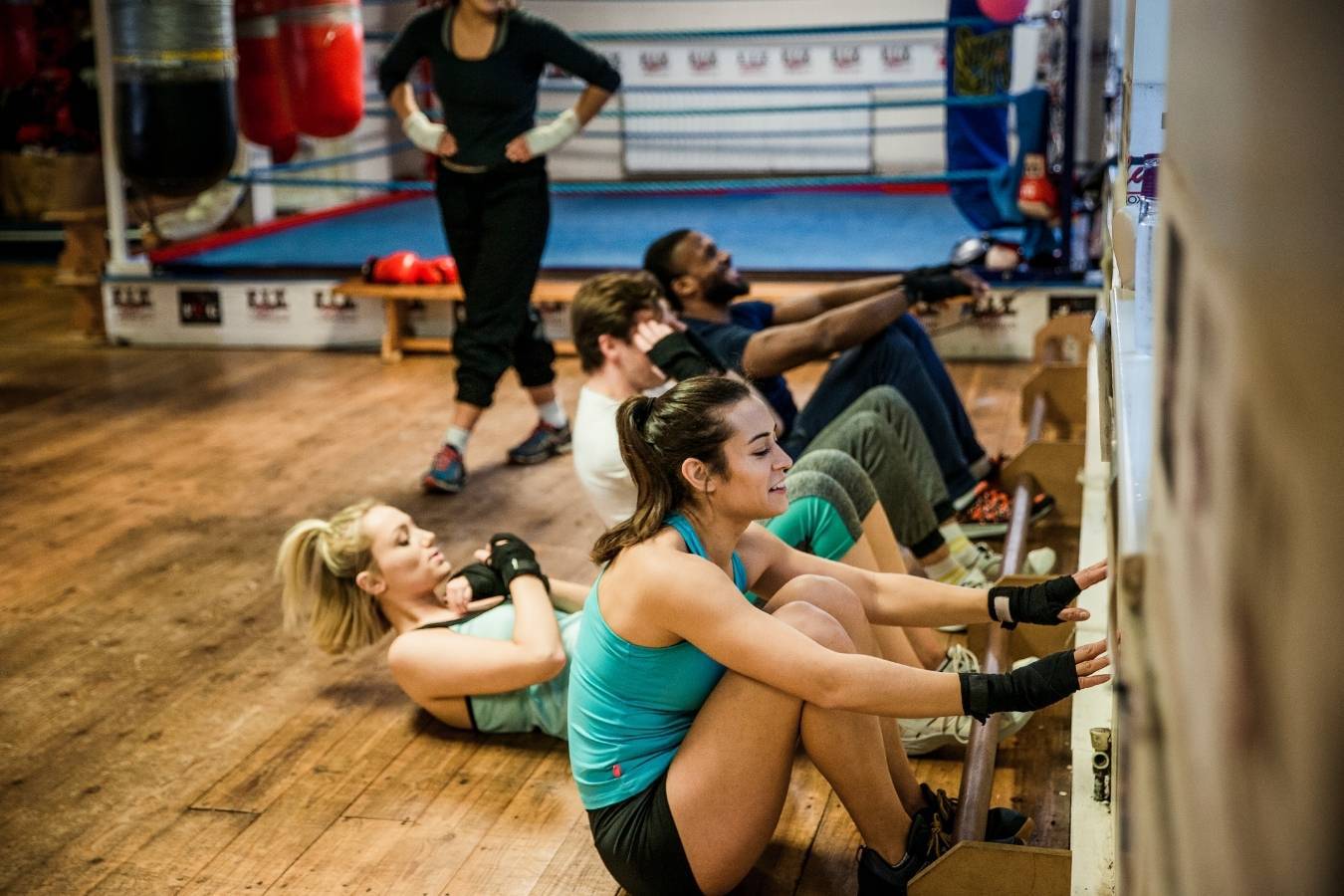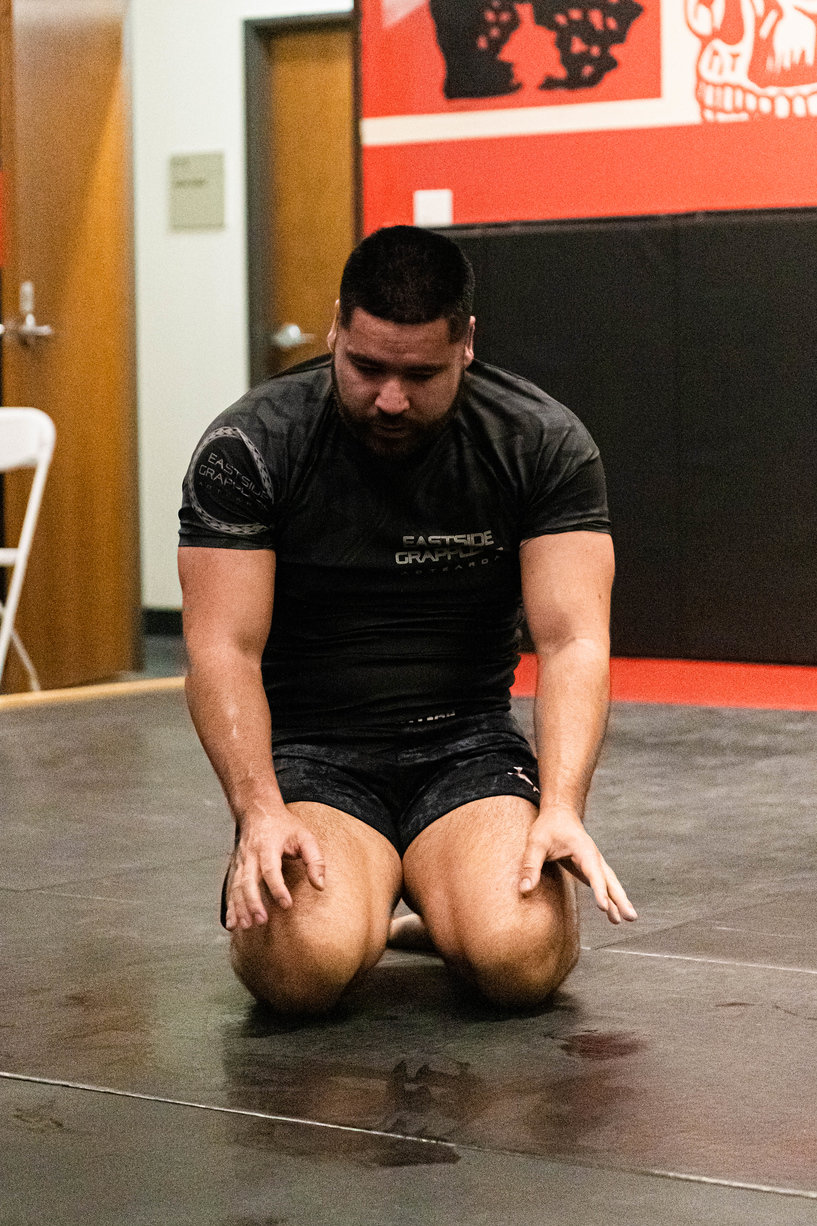Circuit training makes great TV production for upcoming fights. Seeing fighters working hard, bent over with sweat dripping off their face is dramatic. It makes us feel like we are watching a Rocky movie and that all the hard work will pay off in the ring.
But are crazy airdyne sprints mixed with burpees and medicine ball throws in a circuit training fashion performed at maximum effort going to transfer to your boxing conditioning?
Circuit training for boxing works well for developing aerobic conditioning and for promoting recovery. Circuit training should not be performed in an anaerobic lactic environment due to the little involvement of that energy system within boxing.
If circuit training shouldn’t be performed at maximum effort and intensity, then how should we plan circuits that promote the conditioning adaptations we want? To do that, we must first understand what circuit training is.
What Is Circuit Training
Circuit training involves combining multiple exercises that are performed one after the other with minimal to no rest. In my definition, I would class this as performing two or more exercises back to back.

FREE Strength & Conditioning Program To Never Gas Out In The Ring
For example, if you perform two exercises alternating with no rest I would class that as circuit training and I will provide examples later in this article.
Circuit training can be used to target many different physical qualities. However, it tends to work better for some qualities versus others. For example, circuit training doesn’t provide the necessary stimulus for maximal strength training or maximal speed and power training. But may do well when targeting various energy systems.
Personally, I like to use circuits for two different purposes:
Aerobic capacity circuits
Recovery mobility circuits
More on these in a bit…
Why Circuit Training For Boxing?

The main reason for using circuit training for boxing is to reduce the overall boxing load by using different training modalities to target specific physiological adaptations.
Unless you are a full-time professional boxer, this may not be necessary as performing exercise away from boxing is time that can be spent honing your technical skills. Luckily, circuits can also be used in a boxing manner.
Circuits also provide a way to reduce the monotony of exercise. Instead of performing one movement for the duration of your conditioning session, you can have multiple movements to move between.
This means you can cover more skills and more body parts during your conditioning session versus just running as an example.
Circuits For Boxing
Aerobic Capacity Circuits
We know from my previous article “Conditioning for Boxing” that aerobic conditioning is of vital importance to boxing success. In fact, the ability to pump a large volume of blood per heartbeat differentiates success between elite-level amateur boxers.
Circuits are a great way of performing cardiac output or long duration, steady-state exercise. The best way to perform these in my opinion is combining boxing movement with medicine ball throws and skipping. For example:
Exercise | Time |
|---|---|
Skipping | 10 minutes |
Shadowboxing | 10 minutes |
Medicine Ball throws | 10 minutes |
Bag work | 10 minutes |
Shadowboxing | 10 minutes |
Now a circuit like this can be manipulated in many different ways. You can vary the time of each exercise. You can have more or less exercises. You can perform only boxing variations such as shadowboxing, speedball, and bag work. You can even perform a circuit with no boxing movements. How would this look?
Exercise | Time |
|---|---|
Medicine Ball Throws | 15 minutes |
Calisthenics | 5 minutes |
Medicine Ball throws | 10 minutes |
Skipping | 15 minutes |
Calisthenics | 5 minutes |
Ideally, you would only perform circuits such as these when your boxing load is very high and you don’t want to add to it.
The most important thing to note is to keep your heart rate between 130-150 BPM for the entire circuit. If you struggle to do this, you may benefit from only performing one or two exercise variations and doing them for a longer period of time. For example:
Exercise | Time |
|---|---|
Medicine Ball Throws + Skipping | 25 minutes |
Shadowboxing | 25 minutes |
Recovery Mobility Circuits
These circuits make great conditioning fillers during a training week. I first came across these by Eric Cressey, a well-known baseball strength and conditioning coach. His professional baseball players were able to average 145 BPM during these circuits which places you perfectly within the range to develop aerobic capacity.
And you have the bonus of developing range of motion while keeping your joints healthy and muscles happy. So, how do we do this?
I like to perform these circuits in a similar fashion to how Cressey sets his out. And that is multiple supersets of exercises that are performed continuously. These exercises can be set up to address any individual work ons that a boxer may have such as tight hip flexors or shoulder problems. It can also be set up to address typical boxing injuries.
PRO TIP: Alternate standing exercises with floor exercises to keep your heart rate up.
Here’s how you may put your recovery mobility circuit together:
Warm-Up | Time |
|---|---|
Side Shuffle w/ Overhead reach | 2 x 15 m |
Carioca | 2 x 15 m |
Fwd Skip w/ Fwd Arm Circle | 2 x 15 m |
Fwd Skip w/ Bwd Arm Circle | 2 x 15 m |
Exercise | Time |
|---|---|
A1) Squat to Stand w/ Diagonal Reach | 3 x 5/side |
A2) Deadbug | 3 x 5/side |
B1) Knee Hug to Lunge to Twist & Reach | 3 x 5/side |
B2) Mini Band Spider Crawls | 3 x 3 up and down |
C1) Quadruped Thoracic Rotation | 3 x 10/side |
C2) Bottoms Up Kettle Bell Walk | 3 x 15 m/side |
D1) Thoracic Extension Foam Roller | 3 x 10 |
D2) Birddog | 3 x 5/side |
E1) Half Kneeling Band Horizontal Abduction | 3 x 10/side |
E2) Inchworm | 3 x 53 x 10/side |
A mobility circuit like this can be performed on your off day such as a Sunday after Saturday sparring. It’s a low impact way to promote active recovery and develop your aerobic conditioning simultaneously.
Why Circuits Don’t Work Outside Of Aerobic Conditioning
Just doing a quick search for circuit training workouts for boxing brings up a plethora of exercise sequences with burpees, squats, push-ups, swings, and battle ropes. These are all done for reps and rounds with the idea of developing as much fatigue as possible.
Unfortunately, this is not conducive for boxing. We know that the anaerobic lactic energy system plays a very small role in boxing compared to the aerobic and alactic energy systems. So performing ballbusting circuits isn’t going to transfer to your boxing conditioning.
Further, many boxers use circuit training as their strength, speed, and power training in the gym. Again, circuit training provides the opposite stimulus and does nothing to make you stronger, faster, or more powerful unless you are a complete beginner in the weight room.
With minimal rest, minimal loading, limited movement speed, and heavy fatigue, maximal strength or high-velocity strength and never maximized within the training session.
If you are going to use circuit training in your boxing training, make sure to stay as close to the sport of boxing as possible while keeping your heart rate below 150 BPM. Ideally, you want to use circuits only when your boxing load is very high and for aerobic conditioning or recovery purposes.
Summary
Boxing circuit training isn't always about red lining to exhaustion. They can be strategically used to enhance various aspects of your conditioning from mobility to aerobic conditioning.
12 Weeks To Knockout Power!
Train like a professional boxer, develop knockout power, and dominate the ring!




